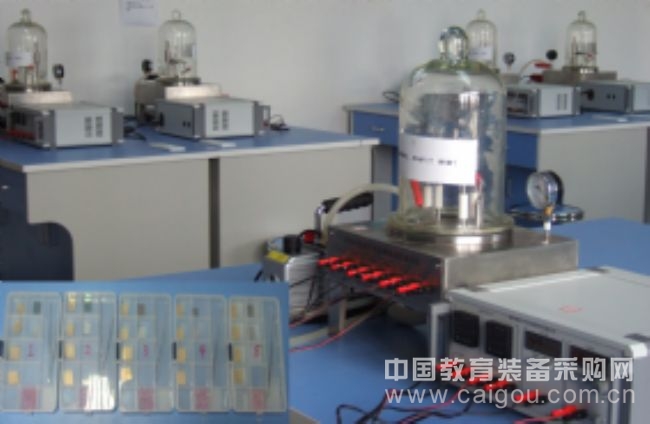
[Seebeck effect experiment instrument] function introduction:
The Seebeck effect is a very important physical phenomenon, which is composed of the combination of the Thomson effect and the Peltier effect. The thermoelectric power generation and semiconductor refrigeration technology developed on the basis of this effect have entered the practical application field, and the Seebeck effect experimental instrument has been developed by introducing this effect into the physical experiment teaching.
The Seebeck effect tester makes the main functional components as independent as possible, and the working components can be conveniently separated into two energy storage blocks (heat source 1 and heat source 2) with thermal insulation and a semiconductor refrigeration component (including two A semiconductor refrigerating chip, one piece of power to generate a temperature difference, the other piece to measure the temperature difference potential, and another anti-air heating contact switch), this structure has two major advantages, one is to make the instrument parts have better interchange Sex, but also convenient for students to understand the structure of the instrument, combined with the role of each component to better understand and master the experimental principles and experimental content.
The experiment instrument adopts a 128╳128d dot matrix liquid crystal screen as the output display, and the output information includes measurement parameters (heat source 1, 2 temperature, heating time, heating times and other information) and system state prompt information, so that the experimental operation process is clear.
The main functions that this experiment can achieve:
1) Instrument setting: According to the needs of the actual experiment, you can set the length of each work to facilitate the arrangement of the experimental class.
2) measuring the temperature difference between the refrigerating efficiency: the operating current electric power W can be I, the operating voltage U and the heating time is consumed in each working period t t is determined, the heat absorption Q1 and the temperature change obtained before and after heating source 1 The heat source 2 flows out of the heat Q2, whereby the cooling efficiency of the semiconductor cooling fin at this temperature difference can be calculated.
3) Verify the law of conservation of energy. The measured heat source 1 absorbs heat Q1 and the heat source 2 flows out heat Q2 to calculate the added energy of the system. The two energy storage blocks are regarded as a system that is insulated from the outside world. The increase of system energy should be The electrical energy consumed by the semiconductor refrigeration chip indicates that the heat absorbed by the system from the outside is equal to the sum of the internal energy of the system and the sum of external work. This is the first law of thermodynamics.
4) Measuring the relationship between the temperature difference electromotive force and the temperature difference: recording the temperature of the two energy storage blocks after each heating and the temperature difference electromotive force of the semiconductor refrigerator 2, the relationship between the temperature difference electromotive force and the temperature difference can be obtained, and the temperature difference is increased and decreased respectively. The relationship between the temperature difference potential and the temperature difference in the process.
5) Verification of the second law of thermodynamics: By experimentally observing the thermal energy transfer process in the two energy storage blocks, it can be concluded that the heat is always automatically transferred from the high temperature object to the low temperature object, but not automatically from the low temperature object to the high temperature. Object, this is the second law of thermodynamics.
Thermal science is an important research field of physics. Thermal experiments and thermal theory have the same important position in teaching. However, there are few experiments related to thermal science at present, especially the lesser experiments that students can do quantitative measurements by themselves. The Seebeck effect tester can perform quantitative measurement experiments to verify the law of conservation of energy and the second law of thermodynamics, increase the teaching content of thermal experiments, and enrich and perfect the thermal experimental system.
The Seebeck effect experiment instrument can simultaneously perform quantitative measurement of the Thomson effect and the Peltier effect, which helps students to change the understanding of the content of the Seebeck effect from a perceptual to a deeper rational understanding.
The experiment based on the Seebeck experimental instrument meets the requirements of cognitive, inspiring, comprehensive and other experimental teaching links and the training of students' hands-on ability. It is conducive to promoting quality education, cultivating innovative spirit and practical ability, and is very suitable for physical experiments and optical information. Technical basic experiment. This experiment has perfect experimental lectures and teaching materials, and has a good prospect of promotion and use.
Various technical indicators of the experiment instrument:
1) Temperature measurement resolution: 0.1 °C
2) Resolution of temperature difference potential measurement: 1mV
3) The cooling plate has anti-air heating protection
4) LCD screen with 128╳128d dot matrix as output display
5) single heating time can be set 30S, 60S, 120S, 240S fourth gear
Name of the work: Seebeck effect tester
Completion unit: Physics Experiment Center, School of Science, Beijing Jiaotong University
MIANYANG BIGANT TECHNOLOGY CO LTD , https://www.bigantech.com
